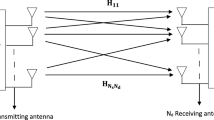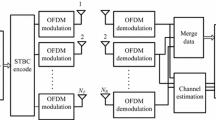Abstract
Multiple-input multiple-output orthogonal frequency division multiplexing (MIMO-OFDM) transmission can improve both the transmission capacity and performance due to diversity gain. However, when the antennas are close to each other in a MIMO-OFDM system, the diversity order will be decreased because of channel correlation. In the paper performance of various detection methods for space–time block code (STBC) MIMO-OFDM with channel correlation are evaluated, including the conventional Alamouti full matrix detection, the modified diagonal matrix detection, the least square-zero forcing (LS-ZF) detection, and the successive interference cancellation (SIC). The paper also verify that the SIC detection can still keep excellent detection performance under large channel correlation.
Similar content being viewed by others
References
Shannon, C. E. (1948). A mathematical theory of communications. Bell System Technical Journal, 27, 379–423, 623–656.
Brandenburg L.H., Wyner A.D. (1974) Capacity of the Gaussian channel with memory: The multivariate case. Bell System Technical Journal 53(5): 745–778
Winters J.H. (1987) On the capacity of radio communications systems with diversity in a Rayleigh fading environment. IEEE Journal on Selected Areas Communications 5(5): 871–878
Bingham J.A.C. (1990) Multicarrier modulation for data transmission: An idea whose time has come. IEEE Communications Magazine 28(5): 5–14
Li Y., Cimini L.J. (2001) Bounds on the interchannel interference of OFDM in time-varying impairments. IEEE Transactions on Communications 49(3): 401–404
da Silva, M. M., Correia, A. M. C., & Dinis, R. (2007). Wireless systems on transmission techniques for multi-antenna W-CDMA systems. European Transactions Telecommunications, doi:10.1002/ett.1252, Published Online: Nov. 2007. (Available: http://dx.doi.org/10.1002/ett.1252)
IEEE Std 802.16e-2005, IEEE Std 802.16-2004/Cor 1-2005. IEEE standard for local and metropolitan area networks, Part 16: Air Interface for Fixed and Mobile Broadband Wireless Access Systems, Amendment 2: Physical and Medium Access Control Layers for Combined Fixed and Mobile Operation in Licensed Bands and Corrigendum 1.
Jeon W.G., Chang K.H. (1999) An equalization technique for orthogonal frequency-division multiplexing systems in time-variant multipath channels. IEEE Transactions on Communications 47(1): 27–32
Wolniansky, P. W., Foschini, G. J., Golden, G. D., & Valenzuela, R. A. (1998). V-BLAST: An architecture for realizing very high data rates over the rich-scattering wireless channel. In Proceedings of IEEE ISSSE’98, Pisa, Italy, Sep 1998, (pp. 295–300).
Debbah M., Loubaton P., de Courville M. (2004) Asymptotic performance of successive interference cancellation in the context of linear precoded OFDM system. IEEE Transactions on Communications 52(9): 1444–1448
Tran, X. N., & Fujino, T. (2005). Groupwise successive ICI cancellation for OFDM systems in time-varying channels. In Proceedings of IEEE ISSPIT’05, Athens, Greece, Dec 2005 (pp. 489–494).
Wang, H., Chen, X., Zhou, S., & Yao, Y. (2005). A low-complexity ICI cancellation in frequency domain for OFDM systems in time-varying multipath channels. In Proceedings of IEEE PIMRC’05, Berlin, Germany, Sep 2005 (pp. 1234–1237).
Alamouti S.M. (1998) A simple transmit diversity scheme for wireless communications. IEEE Journal on Selected Areas Communications 16(8): 1415–1458
Tarokh V., Jafarkhani H., Calderbank A.R. (1999) Space-time block coding for wireless communication: Performance results. IEEE Journal on Selected Areas Communications 17(3): 451–460
3GPP. (2003). Spatial channel model for MIMO simulations, TR 25.996 V6.1.0, Sep 2003.
Salz J., Winters J.H. (1994) Effect of fading correlation on adaptive arrays in digital mobile radio. IEEE Transactions on Vehicular Technoloyg 43(4): 1049–1057
Lee, K. F., & Williams, D. B. (2000). A space-time coded transmitter diversity technique for frequency selective fading channels. In Proceedings of IEEE Sensor Array and Multichannel Signal Processing Workshop’00, Cambridge, MA, Mar 2000 (pp. 149–152).
Ko, E., Joo, P., Kang, C., & Hong, D. (2002). Improved transmit diversity using space-time block coding for OFDM systems. In Proceedings of IEEE MILCOM’02, vol. 2, Anaheim, CA, Oct 2002 (pp. 1034—1038).
Lindskog, E., Vu, M., Tujkovic, D., Artes, H., & Moduludo, S., et al. (2004). Closed loop MIMO precoding. In IEEE C802.16e-04/293r1, Sep. 2004.
Chen, Y.-K., Lee, H. C., You, J.-J., & Wei, S. W. (2007). Less complexity successive interference cancellation for OFDM system. In Proceedings of the IEEE PIMRC’07, Athens, Greece, Sep 2007 (pp. 1–5).
Author information
Authors and Affiliations
Corresponding author
Rights and permissions
About this article
Cite this article
You, JJ., Wei, SW. Performance Verification of Successive Interference Cancellation for STBC MIMO-OFDM System with Channel Correlation. Wireless Pers Commun 50, 529–543 (2009). https://doi.org/10.1007/s11277-008-9622-y
Received:
Accepted:
Published:
Issue Date:
DOI: https://doi.org/10.1007/s11277-008-9622-y




